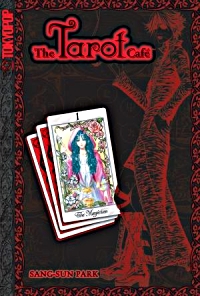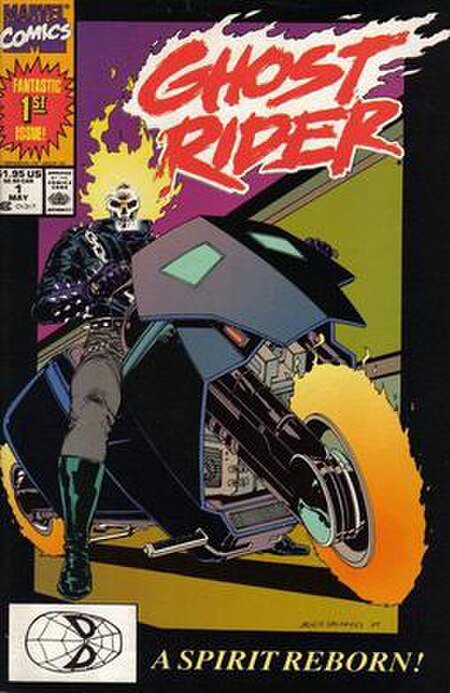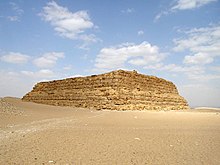Mastaba
|
Read other articles:

Manhwa The Tarot CaféCover, The Tarot Café volume 1 (Tokyopop edition)Genre Horror, romance Mythology AuthorPark Sang-sunPublisher SigongsaEnglish publisher Madman Entertainment Tokyopop Other publishers Deux Studio Soleil Manga Fumax Flashbook La Cupula Comics Factory Volumes7 The Tarot Café is a manhwa by Park Sang-sun (박 상선) being published by Sigongsa in Korea, and distributed by Tokyopop in the United States. Seven volumes have been published in Korea, all of which have been transl…

Marvel Comics fictional character Comics character Danny KetchGhost RiderDanny Ketch on the cover ofGhost Rider: Danny Ketch #1 (Dec. 2008).Art by Clint Langley.Publication informationPublisherMarvel ComicsFirst appearanceGhost Rider vol. 3 #1 (May 1990)Created byHoward Mackie (writer) Javier Saltares (artist)In-story informationAlter egoDaniel Danny KetchSpeciesHuman/demon hybridPlace of originBrooklyn, New YorkTeam affiliationsMidnight SonsSecret DefendersNew Fantastic FourNotable aliasesThe S…

この項目には、一部のコンピュータや閲覧ソフトで表示できない文字が含まれています(詳細)。 数字の大字(だいじ)は、漢数字の一種。通常用いる単純な字形の漢数字(小字)の代わりに同じ音の別の漢字を用いるものである。 概要 壱万円日本銀行券(「壱」が大字) 弐千円日本銀行券(「弐」が大字) 漢数字には「一」「二」「三」と続く小字と、「壱」「弐」…

У этого термина существуют и другие значения, см. Сиротинская. СтаницаСиротинская 49°15′20″ с. ш. 43°40′33″ в. д.HGЯO Страна Россия Субъект Федерации Волгоградская область Муниципальный район Иловлинский Сельское поселение Сиротинское История и география Первое …

1897 Cisleithanian Imperial Council election ← 1891 March 1897 1900–1901 → All 425 seats in the Imperial Council213 seats needed for a majority First party Second party Third party Leader Josef Kaizl Party NSS DLVP PKK Alliance Bohemian Club German Progressive Parties Poland Club Leader since 1895 Last election 9.15% 32.81% 11.62% Seats won 53 50 46 Popular vote 64,546 81,291 26,161 Percentage 6.09% 7.79% 2.46% Swing 3.06% 25.02% 9.16% &#…

1994 video gameAdventures of Yogi BearDeveloper(s)Blue TurtlePublisher(s)Cybersoft GameTek Empire Interactive MagifactDesigner(s)Martin Wakeley (SNES)Composer(s)George Villiers (SNES)Platform(s)Genesis, Super NESReleaseSuper NES NA: October 1, 1994EU: November 24, 1994JP: January 3, 1995[1]Genre(s)PlatformMode(s)Single-player Adventures of Yogi Bear is a platform game published by Cybersoft on October 1, 1994, in North America and later in Japan and Europe. The game is called Yogi Bear i…

هنودمعلومات عامةنسبة التسمية الهند التعداد الكليالتعداد قرابة 1.21 مليار[1][2]تعداد الهند عام 2011ق. 1.32 مليار[3]تقديرات عام 2017ق. 30.8 مليون[4]مناطق الوجود المميزةبلد الأصل الهند البلد الهند الهند نيبال 4,000,000[5] الولايات المتحدة 3,982,398[6] الإمارا�…

Michelle PhillipsPhillips, 1966LahirHolly Michelle Gilliam4 Juni 1944 (umur 79)Long Beach, California, A.S.PekerjaanPenyanyipenulis laguaktrismodelTahun aktif1965–sekarangSuami/istri John Phillips (m. 1962; c. 1969) Dennis Hopper (m. 1970; c. 1970) Robert Burch (m. 1978; c. 1979) Pasangan Grainger Hines (1981–1984) Geoffrey Toze…

此条目序言章节没有充分总结全文内容要点。 (2019年3月21日)请考虑扩充序言,清晰概述条目所有重點。请在条目的讨论页讨论此问题。 哈萨克斯坦總統哈薩克總統旗現任Қасым-Жомарт Кемелұлы Тоқаев卡瑟姆若马尔特·托卡耶夫自2019年3月20日在任任期7年首任努尔苏丹·纳扎尔巴耶夫设立1990年4月24日(哈薩克蘇維埃社會主義共和國總統) 哈萨克斯坦 哈萨克斯坦政府與�…

Questa voce o sezione sull'argomento rugby non cita le fonti necessarie o quelle presenti sono insufficienti. Puoi migliorare questa voce aggiungendo citazioni da fonti attendibili secondo le linee guida sull'uso delle fonti. Segui i suggerimenti del progetto di riferimento. Immagine del Triple Crown Nel rugby a 15 la Triple Crown (Triplice corona) è un riconoscimento originariamente simbolico, messo annualmente in palio tra le quattro nazionali delle isole britanniche di Galles, Inghilter…

Commune in Centre-Val de Loire, FranceMontoire-sur-le-LoirCommuneThe main square of the town Coat of armsLocation of Montoire-sur-le-Loir Montoire-sur-le-LoirShow map of FranceMontoire-sur-le-LoirShow map of Centre-Val de LoireCoordinates: 47°45′18″N 0°51′52″E / 47.755°N 0.8644°E / 47.755; 0.8644CountryFranceRegionCentre-Val de LoireDepartmentLoir-et-CherArrondissementVendômeCantonMontoire-sur-le-LoirIntercommunalityCA Territoires VendômoisGovernment �…

2023 professional crossover boxing match Jake Paul vs. Nate DiazDateAugust 5, 2023VenueAmerican Airlines Center, Dallas, Texas, U.S.Tale of the tapeBoxer Jake Paul Nate DiazNickname The Problem Child Hometown Cleveland, Ohio, U.S. Stockton, California, U.S.Pre-fight record 6–1 (4 KOs) 0–0 (Boxing) 21–13 (5 KOs) (MMA)Age 26 38Height 6 ft 1 in (1.85 m)[1] 6 ft 0 in (1.83 m)[2]Weight 185 lb (84 kg)[3] 185 lb (84 kg)[…

2017 American thriller film HeartthrobDirected byChris SivertsonWritten byChris SivertsonProduced byAimée FlahertyJohn HermannMichael MoranMark MyersStarringAubrey PeeplesKeir GilchristCinematographyGreg EphraimEdited byBen La MarcaMusic byJim DooleyProductioncompanyCitizen Skull ProductionsRelease date June 27, 2017 (2017-06-27) Running time86 minutesCountryUnited StatesLanguageEnglish Heartthrob is a 2017 American thriller film written and directed by Chris Sivertson. It stars …

Annual film festival held in Montreal, Canada Montreal World Film FestivalLocationMontreal, Quebec, CanadaFounded1977Film titles400+Hosted byMontreal World Film Festival GroupLanguageInternationalWebsitewww.ffm-montreal.org[dead link] The Montreal World Film Festival (MWFF; French: le Festival des Films du Monde) was one of Canada's oldest international film festivals and the only competitive film festival in North America accredited by the FIAPF (although the Toronto International Film …

State park in Chautauqua County, New York Midway State ParkLocationMaple Springs, New York, United StatesOpened1898OwnerNew York State Office of Parks, Recreation and Historic PreservationSloganContinuing the TraditionOperating seasonMay – SeptemberAttractionsTotal20WebsiteMidway State Park Midway ParkU.S. National Register of Historic PlacesU.S. Historic district Carousel (1946), July 2012Show map of New YorkShow map of the United StatesLocationNY 430, Maple Springs, New YorkCoordinates42…

Torre VelascaLocalizzazioneStato Italia LocalitàMilano Indirizzopiazza Velasca, 5 Coordinate45°27′36″N 9°11′26″E45°27′36″N, 9°11′26″E Informazioni generaliCondizioniIn uso Costruzione1955-1957 Inaugurazione1961 StileNeolibertyPostmodernismo Usocommercialeresidenziale AltezzaTetto: 106 m Piani26 Ascensori8 RealizzazioneArchitettoStudio BBPR(G. L. Banfi, L. BelgiojosoE. Peressutti, E. N. Rogers) IngegnereArturo Danusso AppaltatoreRi.C.E.Ricostruzione Comparti Edilizi…

Questa voce sull'argomento calciatori italiani è solo un abbozzo. Contribuisci a migliorarla secondo le convenzioni di Wikipedia. Segui i suggerimenti del progetto di riferimento. Attilio GalassiniNazionalità Italia Calcio RuoloCentrocampista Termine carriera1965 CarrieraGiovanili 19??-1951 Lazio Squadre di club1 1951-1954 Rieti? (?)1954-1955 Roma0 (0)1955-1958 Verona59 (10)1958-1959→ Ozo Mantova7 (1)1960 Toronto Italia? (?)1961 Toronto Roma? (?)1…

أمنمعلومات عامةصنف فرعي من حالةفعل الاستعمال موقع ويب يدرسه هندسة أمن له هدف سلامة ممثلة بـ سياقحمايةنوع من الأمن يمارسها security consultant (en) لديه جزء أو أجزاء أمن المعلوماتأمن عامامن الوطن النقيض خطورة تعديل - تعديل مصدري - تعديل ويكي بيانات مقعد قذفي لهروب طيار قبل اصطدام طائرت�…

Santo Fransiskus dari SalesUskup, Pengaku Iman dan Pujangga GerejaLahir1567Château de Thorens, SavoyMeninggal28 Desember 1622Lyon, PrancisDihormati diGereja Katolik Roma, Gereja AnglikanBeatifikasi8 Januari 1662, Roma oleh Paus Aleksander VIIKanonisasi19 April 1665, Roma oleh Paus Aleksander VIITempat ziarahAnnecy, PrancisPesta24 January29 January (General Roman Calendar, 1666-1969)AtributHati Kudus Yesus, Mahkota DuriPelindungBaker, Oregon; Cincinnati, Ohio; Catholic press; Columbus, Ohio; par…

Scottish artist and musician (born 1953) For other persons by the name William Drummond, see William Drummond (disambiguation). Bill DrummondDrummond in 2010BornWilliam Ernest Drummond (1953-04-29) 29 April 1953 (age 71)Butterworth, South AfricaOther namesKing Boy DTime BoyTenzing Scott BrownEducationUniversity of NorthamptonArt and Design AcademyOccupationsArtistwritermusicianmusic industry managerYears active1975–presentMusical careerOriginNewton Stewart, ScotlandLabelsZooKoro…



